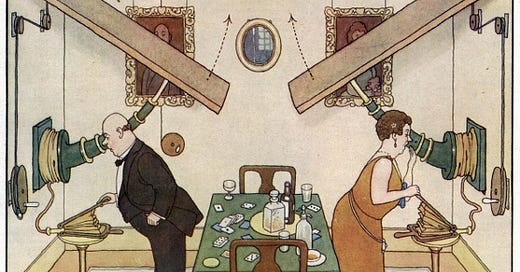The Single Moment That Ruins A Murder Mystery
How to reward cleverness while hiding clues in plain sight
The most brilliant solutions to murder mysteries are those which make the reader say, “Ah, the answer was in plain sight all along!”
The worst solutions to murder mysteries are those which make the reader say, “Yes, the answer was in plain sight all along.”
A great mystery novel should play fair with the reader, presenting clues the reader can use to solve the mystery before the detective reveals the murderer’s identity. But unless those clues are cleverly disguised, they give away the solution far too soon.
In an earlier post, I detailed The Peevyhouse-Chee Rules for Satisfying Murder Mysteries, and the second of those rules is, The solution to the mystery must reward cleverness. Today, we’ll discuss how to hide clues in plain sight while still requiring readers to use logic and deduction to arrive at the correct answer.
Assume Readers Have Uncanny Observation Skills
Picture me standing an inch from my TV screen, my finger on the remote’s pause button, my steely gaze locked on a dartboard barely in focus over an actor’s shoulder. This will give you an idea of how obsessively I searched for hidden ciphers in each episode of The Afterparty, a very fun murder mystery on Apple TV+.
Two-thirds of the way through the second season of the show, my friends and I had filled out a mammoth spreadsheet to track the show’s myriad clues. We had solved the hidden puzzles in every episode, which led us to more puzzles on a secret website associated with the show. (We solved those too.) And then, in Episode 8…
The solution to the mystery appeared onscreen, in plain sight. SPOILER: A character casually reached down and took the wrong drink from a table, leaving behind a presumably-poisoned drink for the victim. Clearly, the drink-switcher was the murderer. (END SPOILER.)
All our work tracking timelines and comparing alibis had been for nothing. Every cleverly-disguised clue leading up to that episode was superfluous. Because one single moment in one single episode revealed the murderer.
Granted, the casual viewer was not studying every frame of the show the way I was. Even so, the moment was apparent enough that a somewhat-careful observer could notice it.
The same problem occurred when I watched Glass Onion. SPOILER: Early on, the victim loudly proclaims, “I’m allergic to pineapple” during a scene that makes his unprompted admission seem a little implausible. Later, the victim drinks a cocktail and suddenly falls down dead. In that moment, I turned to my son and said, “He’s allergic to pineapple,” and my son said, “And someone just switched drinks with him.” I hadn’t noticed the drink-switching moment, but my son had, and anyway, it was easy to guess that this was how the murderer had struck. (END SPOILER)
Again, you might point out that not everyone is so observant. But fans of murder mysteries generally are, and anyway, it’s good practice to reward cleverness over observation. The most observant person in the world should not be able to solve a murder mystery without also making use of logic and deduction. Arriving at the answer without these tools isn’t satisfying—it’s the equivalent to solving a word search puzzle instead of a crossword.
Offer An Alternate Explanation
What deflates both these mysteries is the fact that there is no plausible reason for someone to switch drinks with the victim. (You could say the swap was an accident—but then there wouldn’t be a murder.) As soon as an observant person notices the switcheroo, the fog of mystery evaporates and the truth is prematurely evident.
The reason we see so many fictional victims murdered via the cup switcheroo is that it’s like a magic trick: the victim was murdered before your very eyes! Who doesn’t enjoy a spectacular illusion? But any time a victim falls dead at our feet (so to speak), an alternate explanation is crucial to averting our suspicion.
In Christie’s Death In The Clouds, there’s no cup-switching trick but the murder does happen in plain sight—on an airplane, where some of the passengers’ seats face the victim’s. SPOILER: The murderer walks over to the victim and jabs a poisoned dart into her neck. Why does no one (including the reader) find this remarkable? Because the murderer was dressed as a steward and seemed only to serve the victim coffee. Delivering coffee is the most plausible reason for someone to approach a stranger! (END SPOILER)
In any mystery, observant readers will notice the moment a murder happens—but they won’t suspect that anything suspicious is occurring if they’re offered an alternate explanation.
Look Over Here! Create A Diversion
Another magician’s trick, one that works well in tandem with the employment of an alternate explanation, is to divert the audience’s attention. Glass Onion attempts to do this during the murder scene, when Kate Hudson calls out, “Look at my dress!” and twirls around for a while. The hope is that viewers are so busy looking at Kate that they don’t notice the murderer making stealthy moves in the corner of the screen. But a subtler version of this trick also works great.
In Death In The Clouds, Poirot finds a blowgun shoved into the one of the airplane seats (his own seat, actually!). Because the victim died from a poisoned dart to the neck, the reader assumes that a blowgun delivered the killing dose. How did the murderer evade detection while using something as flashy as a blowgun to launch a poisoned dart past so many passengers? SPOILER: Actually, the blowgun is a diversion. It suggests the murder did not take place at close range, which diverts suspicion from the “steward” who served coffee to the victim. The reader’s focus is directed solely at solving the puzzle of how a dart sailed through the cabin of the plane unnoticed. (END SPOILER)
A diversion doesn’t have to be a sudden occurrence; it only needs to be intriguing enough to claim the reader’s attention. The actual facts of the murder, with their boringly plausible alternate explanations, seem unimportant in contrast.
Require Logic and Deduction
How will the reader solve the mystery if the true facts are obscured by alternate explanations and intriguing diversions? In the case of Death In The Clouds, logic tells us that blowguns are too noticeable to be used to commit murder in front of an audience, and that darts are not well-aimed without one. Therefore, the reader can deduce that no blowgun was used and that the dart was not launched. The only possibility that remains is that the murder was committed at close range. Which means whoever was close to the victim was her murderer.
Death In The Clouds hides another clue in plain sight: the murderer’s disguise is presented on a list of evidence. The reader is unlikely to notice it, though, because an alternate explanation is offered for the disguise. SPOILER: The disguise is listed as a dentist’s coat, and it’s found in the suitcase of the dentist. Nothing could be more ordinary! The clever dentist had gone into the lavatory, put on his dental coat, emerged looking identical the white-coat-wearing stewards, served the victim coffee as he secretly jabbed the dart into her neck, and returned to the lavatory to take off his coat. (The TV episode makes the mystery easier to solve in that viewers can see how similar the dentist’s coat is to the stewards’ uniforms.) (END SPOILER)
Observation alone isn’t enough to solve the mystery of Death In The Clouds. The reader must look past the diversion of the blowgun and refuse to be taken in by alternate explanations for the murderer’s disguise. In this way, the solution requires logic and deduction, and the clever reader revels in a rewarding conclusion. ●
Your Turn
If you want to require your reader to use more than observation to solve your mystery, ask yourself these questions:
How might the moments leading up to the murder pave the way for a plausible but incorrect explanation for a telling clue?
What intriguing clue might provide a selling point for my mystery novel, and how might it divert attention from the true facts of the case?
How might my detective point out the seeming impossibilities of the case so that the reader will be invited to use logic to find a solution?
Did You Miss The 7 Rules For Satisfying Murder Mysteries?
Read the seven rules and a complete breakdown of each, with a thorough case study, at this link:
Download A PDF Version Of The 7 Rules By Clicking Below
If you liked this post, consider supporting The Writer’s Attic by becoming a paid subscriber. You’ll get access to the pdf previewed above plus other helpful writing guides, like the one found here.










